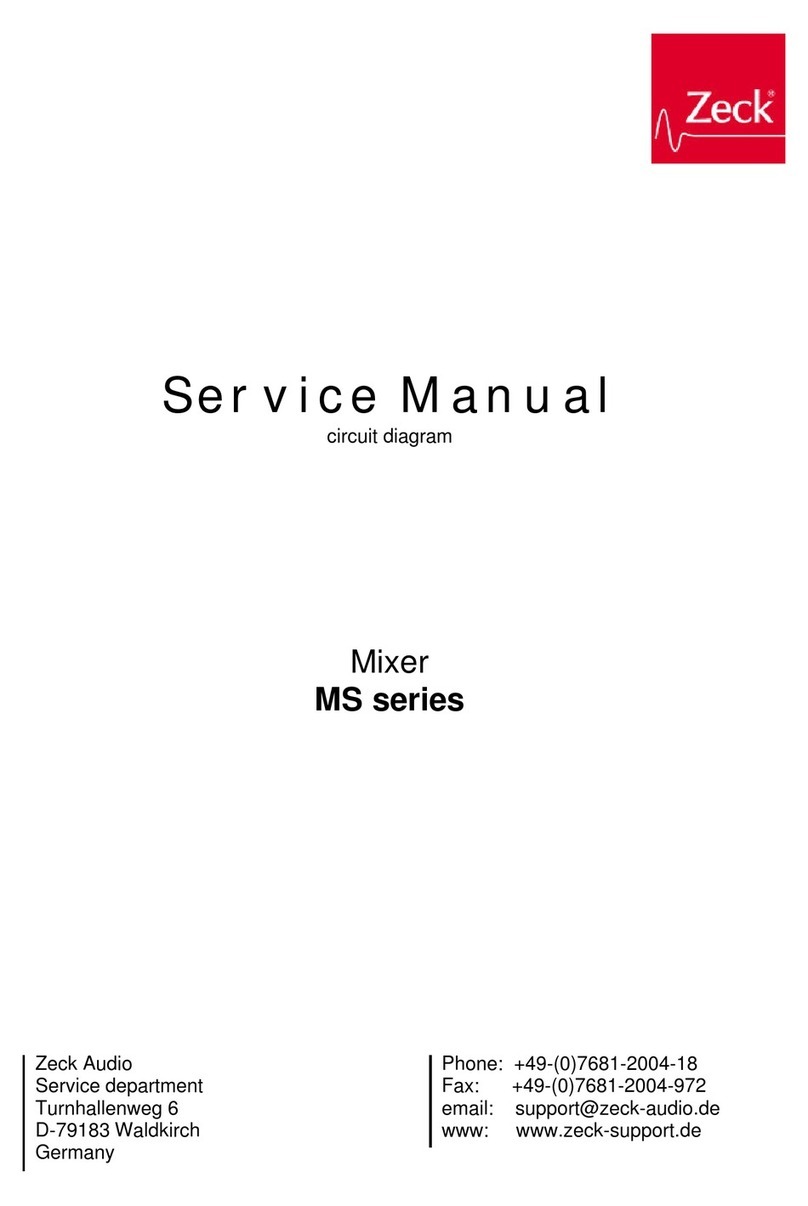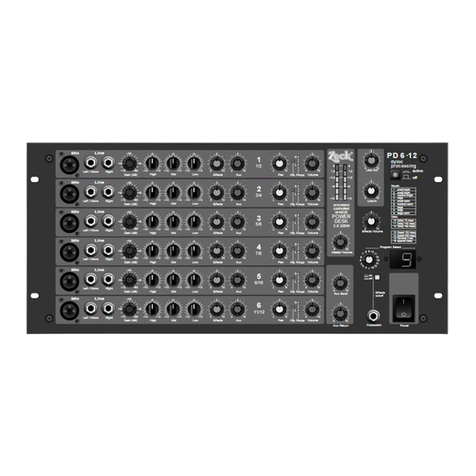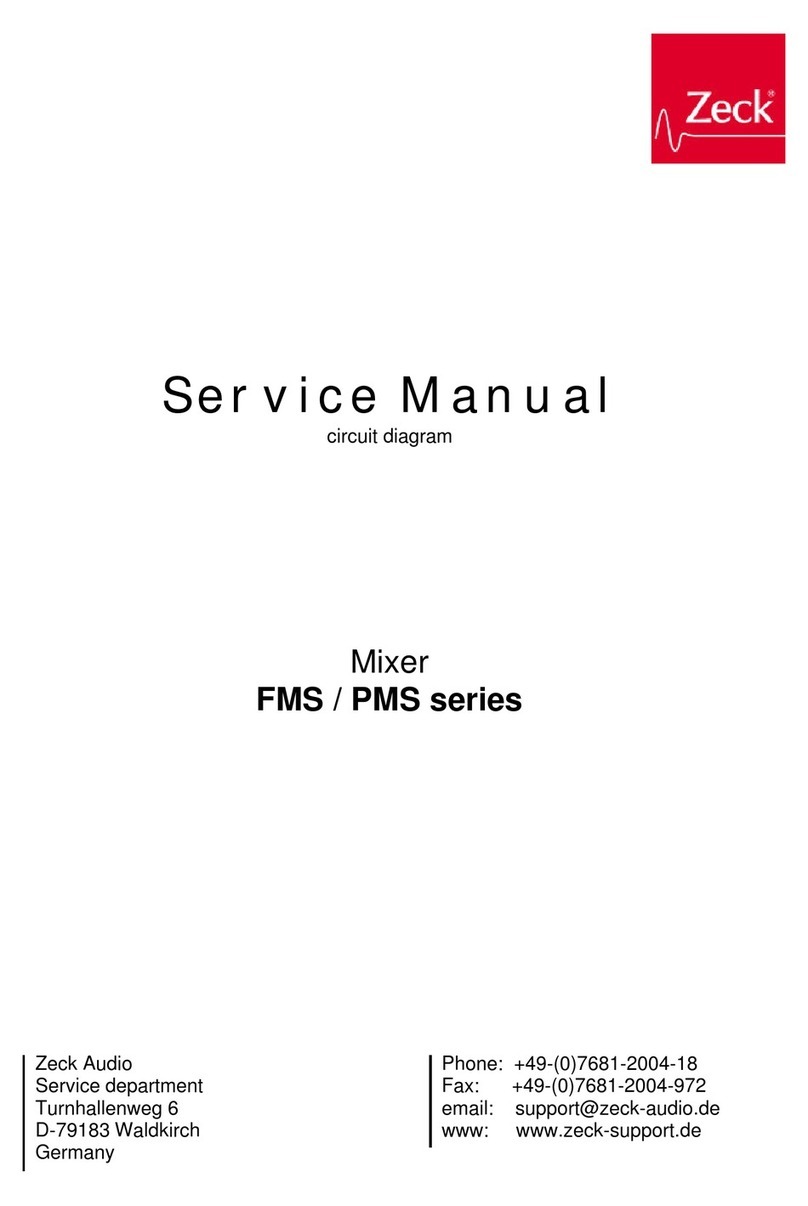Das Eingangssignal(vom Instrument
bzw. Mikrofon) durchläuft zunächst die
Vorverstärkung (Gain). Hier werden die
unterschiedlich starken Signalquellen auf
ein gleiches Spannungsniveau verstärkt
(ca.0 dB).
Die nächste Station ist die Klangrege-
lung. Hier können bestimmte Frequenz-
bereiche des Signales angehoben oder
abgesenkt werden.
Es folgt der Regler für die Monitor-
lautstärke.Dieser Regler sitzt vor dem
Fader (pre fade), d.h. die Monitorlautstär-
ke ist unabhängig von der Fader-(=Ma-
ster) Lautstärke. Man kann also jedes In-
strument mehr oder weniger stark auf
den Monitor geben, unabhängig von sei-
ner Saallautstärke.
Als nächstes durchläuft das Signal den
Fader. Der Fader legt die anteilige Lauts-
tärke des Einzelkanals im Mastersignal
(=Saalsignal) fest.
Nach dem Fader (post fade) folgt der
Regler für dieEffekt-Stärke (Echo, Hall
usw.).
Ein Kanal kann also nur dann mit z.B.
Echo versehen werden, wenn auch der
Kanalfader auf ist.
Die letzte Station im Eingangskanal ist
der Panorama-Regler. Er verteilt das
Mono-Eingangssignal auf die Stereo-Ma-
sterschienen links und rechts. Das Ste-
reo-Mastersignalergibt sich also da-
durch, daß die Eingangssignale in unter-
schiedlichen Anteilen nach links oder
nach rechts gegeben werden. Steht der
Panoramaregler auf Mitte, so kommt das
Signal gleichstark auf beide Master-
kanäle. Die Masterschienen L + R sam-
meln sämtliche Eingangssignale. Die
Masterfader L + Rregeln die gesamte
Ausgangslautstärke des Saalsignals.
Die Monitorschienesammelt die Ein-
gangssignale, die durch Aufdrehen des
Monitorreglers gewollt auf den Monitor
gegeben werden. Der Monitorfaderre-
gelt die gesamte Monitor-Ausgangslauts-
tärke. Die Effektschiene sammelt die
Eingangssignale, die durch Aufdrehen
des Effektreglers gewollt mit einem Ef-
fekt versehen werden sollen. Der Regler
"Effekt Send" regelt die gesamte Aus-
gangslautstärke zum Effektgerät.
Nun sind wir also beim Thema "Ein-
schleifen eines Effektgerätes" ange-
langt. Hier wird es schon etwas schwieri-
ger. Versuchen wir, möglichst einfach
diesen Vorgang bei einem Echogerät zu
erläutern. Was am Effekt Send zur Verfü-
gung steht, ist ausschließlich eine Sum-
mierung der Eingangskanäle, die
gerne Echo hätten. Dieses trockene
Summensignal gelangt nun also auf
den Eingang (Input) des Echogerätes.
Das Echogerät nimmt dieses Signal und
verlängert es um bestimmte einstellbare
Zeitintervalle (mehrfach). Diese verzö-
gerten Signale stehen jetzt also am "Ef-
fect Out" des Echogerätes zur Verfü-
gung. Man verbindet "Effect out" mit der
"Effect return"-Buchse am Mischpult.
Jetzt gelangt das verzögerte Signal
wieder zurück ins Pult, wird mit dem Ef-
fect-Return-Regler in der Lautstärke
eingestellt und wird über den Effect Pa-
norama-Regler wieder dem Mastersig-
nal zugemischt. Nun ergibt sich eine
Überlagerungdes trockenen Master-
Signals mit dem verzögerten Effect-Re-
turn-Signal und siehe da: der Sänger
singt mit Echo. So einfach ist das. Oder
doch nicht? Natürlich, es gibt ja auch
noch stereo-Effekte. Aber dazu kommen
wir später.
Was man noch aus dem vereinfachten
Blockschaltbild gut erkennen kann, ist
die Frage nach Mono und Stereo der
verschiedenen Wege:
Jeder Eingangskanal ist Mono. Wer
also z.B. ein Stereo-Keyboard anschlies-
sen will, braucht zwei Eingangskanäle
und muß die beiden Panoramaregler je-
weils auf L und R stellen.
Die Monitorschieneund damit derMo-
nitorausgangsind Mono. DieEffekt-
schiene und damit der Ausgang zum Ef-
fektgerät (Effect send) sind Mono. Ste-
reo-Effektgeräte erzeugen aus einem
Mono-Eingangssignal ein Stereo-Effekt-
Ausgangssignal. Die Masterschiene
L/R ist Stereo.
Auf unserem vereinfachten Prinzip-
schaltbild in Abb.1 sind der Effekt- und
der Panoramaschalter aus Übersichtlich-
keitsgründen unterhalb des Faders posi-
tioniert. In der Praxis befinden sich im In-
teresse der besseren Bedienbarkeit
diese Regler oberhalb des Faders.
The input signals(from instrument or
mike) run firstly through the pre-amplifi-
cation (gain) where their differing source
strengths are brought up to a common
level (around 0 dB).
The next stop is the equalisation
where particular frequency areas can be
strengthened or diluted.
Next comes themonitor volume con-
trol which is pre-fade and therefore inde-
pendant of the fader (master) volume.
This means that one can channel more
or less of an instrument´s signal over the
monitors, no matter what is coming over
the main speaker system.
The signal then reaches the fader
which conveys the chosen signal
strength of each individual channel to the
master signal (main system). The ef-
fects-strength control(echo, delay
etc.) is post-fade. One channel can, for
example, only be given echo, when its
fader is open.
The last stop in the input channel is the
panorama controlwhich divides the
mono input signal proportionally between
the stereo master left/right channels, de-
pending on the positon of the rotary con-
tol. If it is centrally positioned (0) the sig-
nal is equally divided. All in-going signals
are collected atmaster L/R and the ma-
ster faders (L/R) control the overall
strength of the final out-going signal.
The monitor routecollects all in-going
signals which are deliberately chan-
nelled to them through the individual mo-
nitor channel controls and the monitor
fader controls the volume of the overall
and final monitor output signal. The ef-
fects route collects all in-going signals
which have been deliberately effected by
use of the individual channel effects con-
trols. The "effects send" control regula-
tes the overall output volume to the ef-
fects equipment. This is where we come
to the subject of "cutting in effects" which
is slightly more difficult. Let´s try to de-
monstrate, as simply as possible, how
this is done with echo: what we have at
effects send is simply the sum of all the
signals awaiting echo treatment. This
dry signal is relayed to the input on the
echo equipment which then takes it and
delays it repeatedly in time intervals
which can be regulated. These delayed
signals are now available in the effects
equipmentoutput. This is then connec-
ted to the "effects return" socket on the
mixer and the delayed signal gets back
into the desk.
Its volume is regulated by the "effects
return" control and mixed in to the ma-
ster signal over the effects panorama
control. Thedry master signalis now
"coated" with the delayed effects return
signal and suddenly the singer´s voice
has an echo. It´s that simple - or per-
haps not. There are also, of couse, ste-
reo effects but we`ll get to them later.
What the circuit diagram also clearly
shows is the question of mono and ste-
reo in the various routes:
Each input channelis mono. If you
want to connect a stereo keyboard, for
example, you need two channels with
the panorama controls set to L and R.
The monitor sectionand the monitor
output is mono.
The effects section and its outputs
(effects send) aremono.Stereo effects
change a mono in-going signal into ste-
reo. The master L/R route is stereo.
Our simplified diagram shows the pan-
orama control below the fader for easier
comprehension. In the interests of better
workability they have, in practice, been
placed above the faders.
4




































